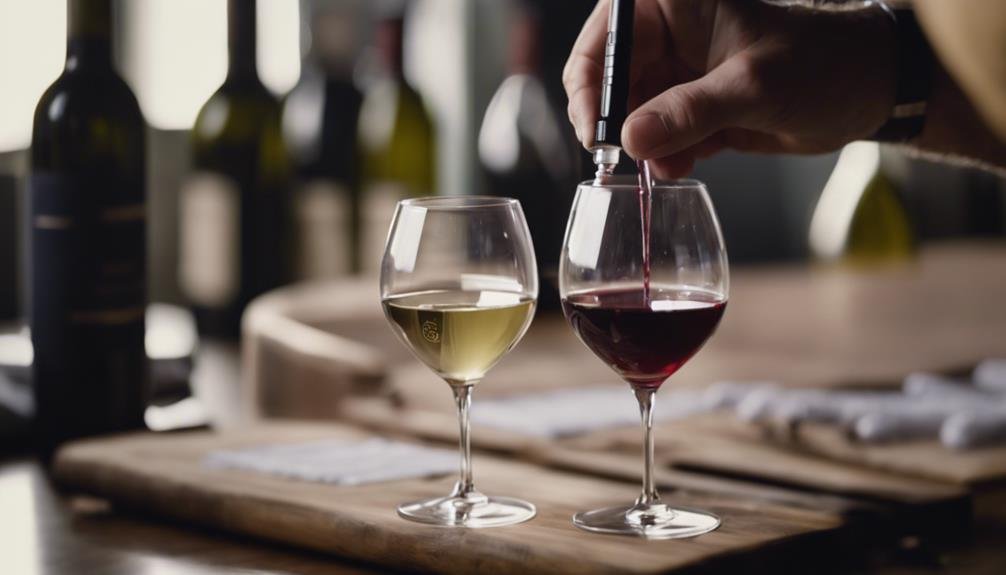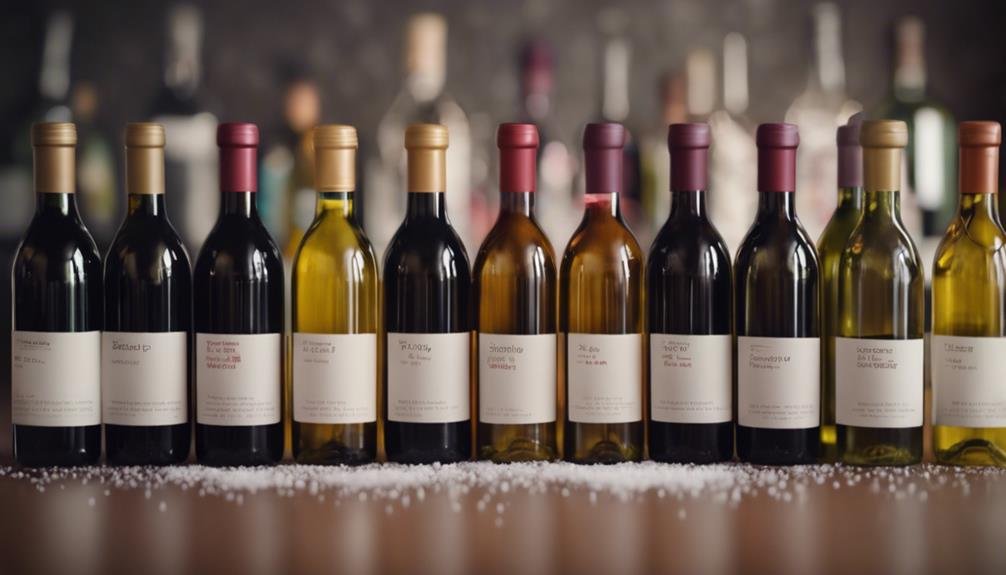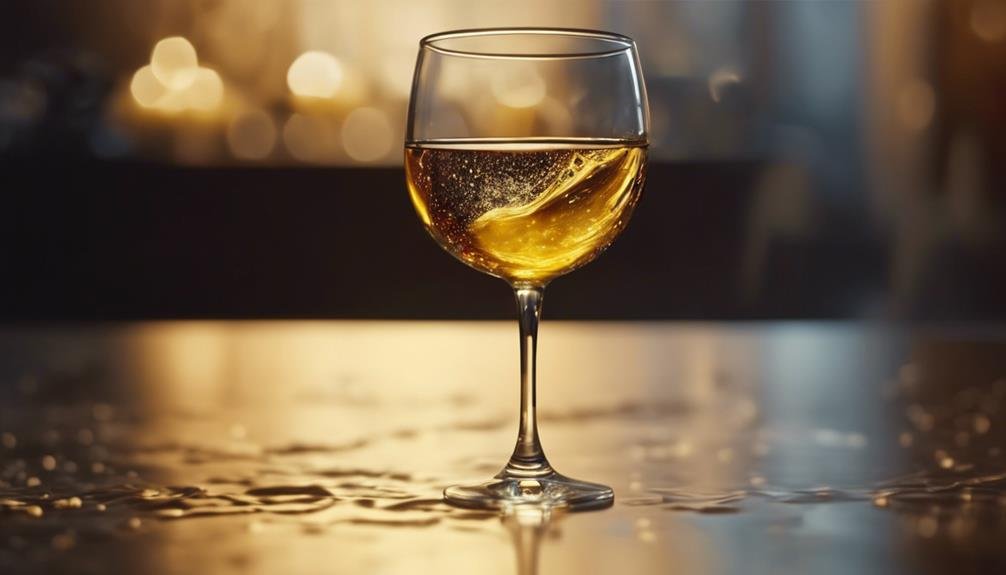Understanding wine sweetness involves deciphering residual sugar's role. During fermentation, yeast converts grape sugars to alcohol, affecting sweetness. Dry wines have low residual sugar as yeast consumes sugars entirely. Conversely, sweet wines pause fermentation to retain sugars. Measuring sugar in wine is crucial, with levels indicated in grams per liter. Hidden sugars may not be evident solely by taste, underlining the importance of disclosing sugar content. Exploring wine regions with cooler climates and consulting experts can guide choices for lower-sugar options. Unravel the complexities of wine sweetness to reveal a deeper appreciation of its nuances.
Understanding Residual Sugar in Wine
Residual sugar in wine, the unfermented sugars left behind after the winemaking process, plays a significant role in determining the sweetness levels of different wine varieties. Sugar fermentation by yeast during winemaking converts grape sugars into alcohol.
The amount of residual sugar remaining in the wine affects the perceived sweetness levels. Dry wines have minimal residual sugar as the yeast consumes almost all the sugar, resulting in higher alcohol content. In contrast, sweet wines have lower alcohol levels because the fermentation process is halted before all the sugar is converted.
Understanding residual sugar content is essential for grasping the varying sweetness perception in wines and is often measured in grams per liter or as a percentage to indicate the sugar levels accurately.
The Role of Yeast in Sugar Levels
Yeast plays a pivotal role in determining the sugar levels present in wine during the winemaking process. Through yeast fermentation, sugar consumption occurs, leading to the production of alcohol. Dry wines have minimal sugar content because the yeast consumes all available sugars, resulting in higher alcohol levels.
In contrast, sweet wines retain some sugar as the fermentation process is halted before complete sugar consumption. This difference in sugar levels affects the overall sweetness and alcohol content of the wine.
Understanding how yeast interacts with sugars is essential in crafting wines with specific characteristics, whether dry or sweet, as it directly influences the final taste profile and style of the wine produced.
Importance of Measuring Sugar Content

Accurate measurement of sugar content in wine is essential for understanding its composition and determining its taste profile. Sugar analysis plays an important role in evaluating the sweetness of wine. By quantifying the sugar levels in grams per liter, producers can create wines with specific sweetness levels.
This information is crucial for consumers who have preferences for dry or sweet wines. Understanding the sugar content allows for precise labeling, giving consumers clarity on what to expect from a bottle. Additionally, sweetness evaluation aids in categorizing wines into different styles based on their sugar levels.
Hence, measuring sugar content is not only a technical aspect of winemaking but also a fundamental factor in enhancing the overall wine experience for enthusiasts and connoisseurs alike.
Revealing Sugar Levels in Wine
Understanding the sugar content in wine is pivotal for both producers and consumers alike in evaluating its sweetness profile. Detecting sweetness in wine can be challenging, as hidden sugars may not always be apparent by taste alone. Wineries are not obligated to disclose sugar levels on labels, making it essential for consumers to rely on other sources of information, such as tech sheets provided by the winery.
These documents offer valuable insights into residual sugar levels, aiding in the selection of wines that align with personal preferences for sweetness. By familiarizing oneself with how to interpret this data, consumers can make more informed choices when it comes to selecting wines that suit their taste preferences regarding sugar content.
Strategies for Choosing Low-Sugar Wines

When seeking wines with lower sugar content, consumers can employ various strategies to make informed and enjoyable selections.
- Check Alcohol Level: Higher alcohol content often indicates lower sugar.
- Explore Wine Regions: Cooler climates tend to produce wines with higher acidity, balancing sugar.
- Research Wine Styles: Dry wines typically have lower sugar levels compared to sweet varieties.
- Consult Wine Professionals: Sommeliers or wine shop staff can provide guidance on low-sugar options.
These strategies help in making conscious wine selections while keeping sugar awareness in mind. By understanding the nuances of wine selection and being mindful of sugar content, individuals can enjoy a wide range of flavorful wines without excessive sweetness.
Frequently Asked Questions
Can I Detect Sugar in Wine by Taste Alone?
Detecting sugar in wine by taste alone is challenging due to palate sensitivity variability. Blind tasting can help test sugar detection abilities. Understanding sugar levels enhances wine appreciation. Utilize tech sheets or expert guidance for accurate sweetness identification.
Are Tech Sheets the Only Way to Find Sugar Levels?
While tech sheets provide valuable insights, they aren't the sole method for discovering sugar levels in wine. Analytical tools, taste buds, lab testing, and visual inspection offer alternative means for detecting sugar content, empowering wine enthusiasts with diverse detection strategies.
Does Higher Price Always Mean Lower Sugar Content?
Price correlation in wine doesn't always guarantee lower sugar content. Perception of sweetness varies; taste alone can't accurately determine sugar levels. Reliable tech sheets provide accurate data. Understanding the relationship between price, sweetness, and taste recognition is key.
How Can I Identify Sugar Levels in Sparkling Wines?
In the effervescent world of sparkling wines, discerning sugar levels can be like deciphering hidden stars in the night sky. Utilize sugar testing methods and hone your sweetness perception to reveal the delicate balance in each flute.
Are There Specific Wine Regions Known for Low-Sugar Options?
Certain wine regions are associated with low-sugar options due to terroir and grape varietals. Areas like Champagne, Chablis, and Marlborough produce dry wines with minimal residual sugar. Understanding regional influences on sugar content helps in selecting wines tailored to personal preferences.
Conclusion
In the world of wine, the intricate dance between sugar and yeast shapes the flavors we savor. Understanding the secrets of residual sugar reveals a spectrum of taste experiences.
So next time you raise a glass, remember, the sweetness in wine may just be the key to discovering a world of complexity and delight. Cheers to the sweet mysteries of wine!
